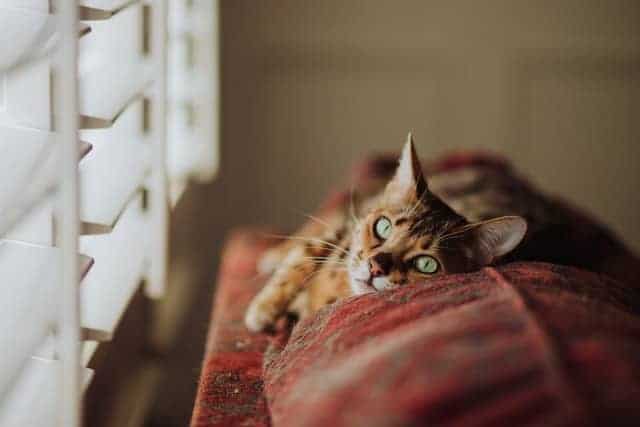Unfortunately it also happens to our cat to feel bad. Your urine can take on a variety of colors, but when should you worry?

Only those who own one know that having a cat at home means never getting bored. His cunning and intelligence frame his being a great curios one: he is able to combine every possible prank but, then, how would we scold him when he comes to ruffle himself? Well yes, he knows he has us in his hand. Sometimes, however, our cat can feel unwell and we realize it from how it changes towards us and in its habits. It is very important to keep an eye on the color of your urine: there are cases where you need to worry.
Urine in the cat
We know that the nature of the cat is to be a hunter and, from such, it marks its territory to make it clear who is in charge.
There are many situations in which a cat could use urine to put its signature on the space in which it moves:
- The male cat does it when it senses the presence of a cat in heat, obviously both not sterilized: in this way it releases sexual pheromones to attract the cat;
- When he senses the presence of strangers : his urine marking indicates that he does not want them in his territory;
- If you are in a condition of great stress : a peaceful environment in the house, the loss of the owner, the arrival of new animals or a child, the change of house.
Normally, however, the cat performs its physiological function by choosing the place to urinate itself: sometimes it does not coincide with the litter box and a series of mechanisms must be undertaken to teach it to use it.
The feline nature of the cat also manifests itself when it pees : it digs deeply and then covers it and all this exclusively to ensure that the prey does not smell its smell and can escape.
Without interfering too much in his feline way of life, we should also observe the cat when he does his needs, to understand if he is well or there is some problem.
It is also important to pay attention to your cat’s behaviour when urinating, apart from its color, noting if:
- Cat no longer digs;
- feels the urge but struggles to pee;
- despite being educated to the litter box, he anxiously looks for a corner where he can do it;
- he makes strange noises trying to squeeze himself;
- since she can’t pee she refuses food;
- he is restless.
Already these are alarm bells that make us tend to consult the veterinarian : based on what we have noticed, after having visited the cat and analysed his urine he will be able to better explain the situation.
When to worry
We know that the waste of many substances is expelled through the urine, both in the case of food and possibly drugs, so it is normal if at times these appear a little loaded.
But what if our cat always ate the same things and did not take any medicine but had urine of a strange color?
In fact, the urine could have various colors and, consequently, various clinical meanings:
- Whitish urine : Indicates the presence of calcium oxalate crystals but may also contain bacterial material due to bacilli or cocci; in this case, in addition to finding the pathogens, we would also have the presence of white blood cells in the urine.
- Amber urine : They are quite thick and it could be because our cat doesn’t drink as much. Sometimes thick urine indicates the presence of glucose (a condition of high stress can involve its presence in the urine, but it can also be due to metabolic diseases such as diabetes or thyroid problems), the presence of proteins (the cause could be the presence of too many proteins in the diet or urinary tract infections), presence of ketone bodies.
- Brown urine : There is a strong dehydration in the animal and, if it is a brown to greenish, there could be problems related to liver function.
- Urine ranging from pink to deep red : If the cat takes drugs, a pink color could also be normal. However, red recalls blood and the presence of blood leads to any urinary infections or problems of the entire uro-genital system, up to being caused by tumors. Any accidents, in which the cat’s kidneys have been affected, can also cause blood in the urine.
- Dark yellow colored urine with foam : Indicate an excessive presence of proteins, due either to an unbalanced diet (in this case the urinary pH would be acidic) or to a liver difficulty in metabolizing them.
Only the veterinarian will be able to better understand which specific cause involves a coloration of the urine rather than another, and certainly direct us in the best way towards therapy.
Useful tips

It is of fundamental importance to always seek help from the doctor and never rely on do-it-yourself; to risk for our wrong approach to the situation would be only our Kitty .
Periodically bringing the cat to the vet’s check-up would allow us to rest assured; any health problem would be caught in time and therefore our cat would not risk complications.
Without a doubt, a balanced diet for the cat is always an excellent prevention, together with a correct hygiene and a not too sedentary life.
The cat may be predisposed to having liver problems: therefore, the liver should not be overloaded by inserting high-protein foods into its diet or foods that contain complex proteins, which are difficult to metabolize.
If there is a condition of kidney stones in the cat it is good to make sure that he drinks a lot, to dilute the urine as much as possible, and that he eats those foods recommended by the veterinarian. In this case, cats feels a lot of pain and only the doctor will be able to rule out a potentially fatal urethral plug.
Urinary infections in cats are very frequent, such as cystitis: the veterinarian will prescribe antibiotics to give to our cat and will recommend a simple and free from irritating substances, to be associated almost always with the use of lactic ferments.
Unless it is a tumor, in almost all pathologies affecting the urinary tract in cats, the intake of food containing too many minerals such as calcium (Ca), phosphorus (P) and magnesium (Mg) is not recommended: formation of kidney sand up to the stones.
Also giving vitamin C to the cat would help to help it in case it suffers from a bacterial infection : its acidity modifies the pH of the urine and favours the elimination of bacteria, thus also helping the action of antibiotics.
In any case, guaranteeing a peaceful and stress-free home environment for our cat is certainly positive for the success of the therapy. Animals are habitual, at the slightest change we should notice it is good to contact the veterinarian.






